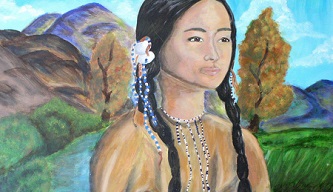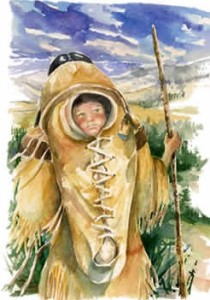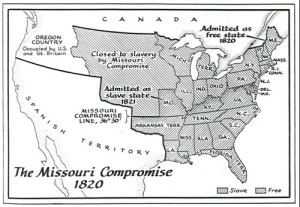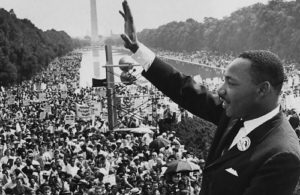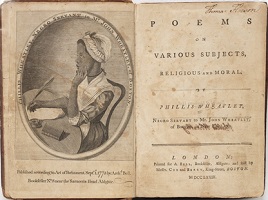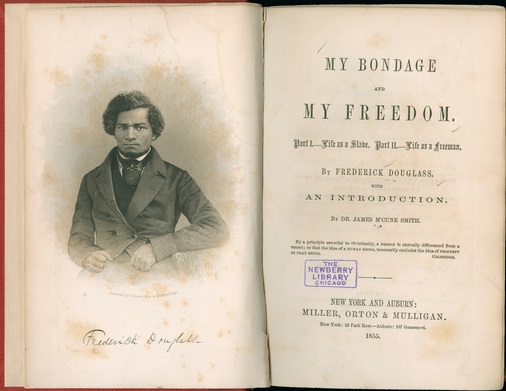Sacagawea was a Lemhi Shoshone Indian girl who accompanied the Corps of Discovery expedition led by Captains William Clark and Merriwether Lewis to explore the American Northwest. Sacagawea’s image was popularized in the early 20th century as a significant historical character after the publication of a novel by Eva Emery Dye, Conquest: The True Story of Lewis & Clark. She is known as the heroine of the Lewis and Clark expedition and over the years her personality has developed into a legend and become part of American mythology.
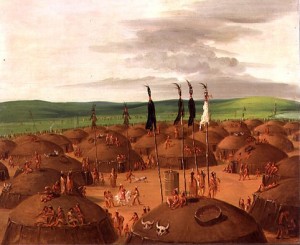
Sacagawea and Charbonneau lived in this cluster of earth lodges at the Hidatsa village. Painting by George Catlin. National Museum of American Art, Smithsonian Institution, Gift of Mrs. Joseph Harrison Jr.
Sacagawea may have been born around 1788 in Lemhi County, Idaho and belonged to the band of Agaidikas of the Lemhi Shoshone tribe also known as Snake Indians. When she was twelve or thirteen years old she was kidnapped by the Hidatsas. A French Canadian fur trapper named Toussaint Charbonneau, who lived among the Hidatsas, took interest in Sacagawea. It is not clear whether Charbonneau bought her or won her in a gamble, but he made her one of his wives. Toussaint had another Shoshone wife “Otter Woman”. More in biography >>
Much of what we know about Sacagawea is first hand information from the journals of the Corps of Discovery. A great deal of information about this Native American legend comes from oral tradition and speculation, starting from her name which can be spelled Sacagawea, Sakakawea or Sacajawea which could mean “Bird Woman” in Shoshone or “Boat Launcher” in Hidatsa. The controversy extends from her role and significance in the Corps of Discovery expedition to the year of her death which has been documented as 1812 or 1884. There is no image or portrait made of Sacagawea during her lifetime, all current images are part of the public imagination.
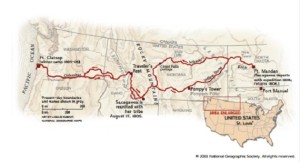
The Corps of Discovery route from Fort Mandan to the Pacific, 5,000 miles, 16 month journey. Click on map to enlarge.
In 1804 President Jefferson ordered the exploration of the new Louisiana Purchase lands. William Clark and Merriwether Lewis were put in charge of the Corps of Discovery expedition. The objective was to map the new territory, establish a relationship with local tribes, study its natural resources and most importantly establish the government’s presence for legal claim. The expedition departed on May 1804 and arrived at Mandan and Hidatsa lands on November 1804 where they settled for the winter. Here is where Lewis and Clark met Charbonneau, Sacagawea’s husband, and hired him as an interpreter.
Sacagawea travelled with her husband because she spoke the Shoshone language and Charbonneau did not. It was important for the expedition to build a relationship with the Shoshoni people as they had horses, much needed for the rest of the expedition. However Sacagawea was not in the payroll and her role was not formally that of a guide. Sacagawea and her 55 day old son, Jean Babtiste, departed on April 17, 1805 and traveled a total of 5,000 miles (8,000 km) for a duration of 16 months.
Her presence proved to be her greatest contribution and was regarded as a token of peace between the expedition and the Indians. Rightly, Native Americans perceived white people as violent and thought they wanted to expropriate their lands but Sacagawea, with her son in her back, reassured Native American tribes that they were peaceful explorers.
Clark wrote: “The wife of Shabono our interpreter we find reconciles all the Indians, as to our friendly intentions a woman with a party of men is a token of peace”
Her courage, alertness and presence of mind proved to be an asset as she was credited for saving invaluable documents from being lost forever when the boat in which they were traveling capsized. Her valor and determination cannot be doubted. The explorers appreciated Sacagawea’s presence among the expedition members; she taught the team how to survive in the winter by eating roots and local fruits until then unknown to the explorers. Her son, Jean Babtiste, won the hearts of the explorers specially Clark who offered Charbonneau and Sacagawea to give him an education and raise him as his own child.
Sacagawea has become an icon, an Indian American folk heroine and a symbol of women’s independence. Today her significance lies in the bridge she built between the Native Nations and the white explorers. Many statues honoring Sacagawea have been erected to honor her contribution. In 2000 a Sacagawea golden dollar was issued by the US Coint Mint.
